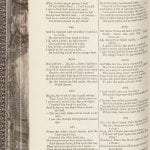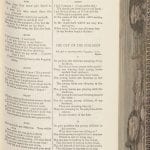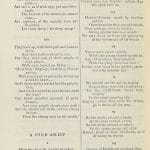
VI: Justice Loves Company: The Cry of the Children perceived in Poems (1850)
When first published in Blackwood’s Edinburgh Magazine in 1843, The Cry of the Children was preceded by a satirical poem, Jolly Father Joe, affecting readings of EBB’s poem. Blackwood’s was a politically conservative publication, so perception of Cry would have been determined mainly by the magazine’s readership. A year later, in the second edition of her collected Poems, Elizabeth Barrett Browning put The Cry of the Children between The Runaway Slave at Pilgrim’s Point and A Child Asleep. Placement between these poems is significant because the reception of Cry is strengthened by the similar tone and themes exuded in these two poems.
- The Runaway Slave at Pilgrim’s Point in The Poetical Works of Elizabeth Barrett Browning, p. 230
- The Cry of the Children, p. 231
- A Child Asleep, p. 234
Our wounds are different. Your white men
Are, after all, not gods indeed,
Nor able to make Christs again
Do good with bleeding. We who bleed
(Stand off!) we help not in our loss!
We are too heavy for our cross,
And fall and crush you and your seed.
Now, look at the ending stanzas of Cry of the Children (first) and A Child Asleep (second):
They look up, with their pale and sunken faces,
And their look is dread to see,
For they think you see their angels in their places, With eyes meant for Deity;—
“How long,” they say, “how long, O cruel nation,
Will you stand, to move the world, on a child’s heart,— Stifle down with a mailed heel its
palpitation,
And tread onward to your throne amid the mart?
Our blood splashes upward, O our tyrants, And your purple shews your path;
But the child’s sob curseth deeper in the silence
Than the strong man in his wrath!”
He is harmless—ye are sinful,—
Ye are troubled—he, at ease:
From his slumber, virtue winful
Floweth outward with increase—
Dare not bless him! but be blessed by his peace—
and go in peace.
How do these two stanzas work together to evoke emotional responses?
How are the oppressors and oppressed contrasted?
How does the religious language in these stanzas strengthen EBB’s appeal to social justice?
Post created by Connor Watkins


